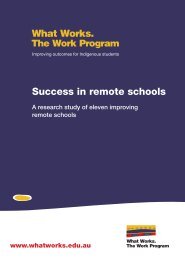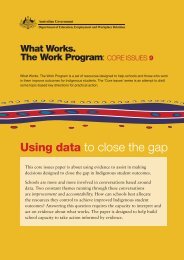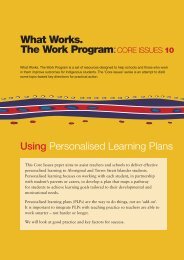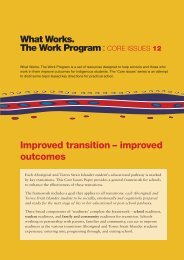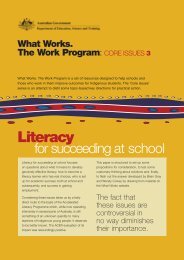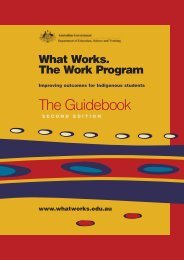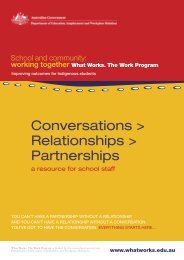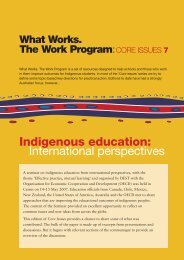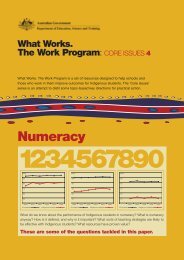Bound for Success Scope and Sequence Statements
Bound for Success Scope and Sequence Statements
Bound for Success Scope and Sequence Statements
- No tags were found...
You also want an ePaper? Increase the reach of your titles
YUMPU automatically turns print PDFs into web optimized ePapers that Google loves.
MATHEMATICSWorking Mathematically(Note that this str<strong>and</strong> should be addressed simultaneously with all mathematics content str<strong>and</strong>s)Concept In Year 1the student:In Year 2the student:In Year 3the student:In Year 4the student:In Year 5the student:In Year 6the student:In Year 7the student:In Year 8the student:In Year 9the student:Contextualising<strong>and</strong> Posingquestions• Talks about where they seenumbers, shapes <strong>and</strong>measurements <strong>and</strong> givesexamples of some of theways they <strong>and</strong> theirfamilies use numbers (e.g.says “there are numberson our phone <strong>and</strong> on footyjumpers”)• Knows that numbers areused <strong>for</strong> differentpurposes; some to tell howmany (cardinal), others aslabels (nominal) <strong>and</strong> othersto describe order (ordinal)• Describes some of theways they <strong>and</strong> their friends<strong>and</strong> families use numbers,shapes <strong>and</strong> measurements(e.g. says “we use thenumbers on the clock totell us when to havelunch” <strong>and</strong> “Mummeasures the flour whenshe makes a cake”)• Identifies <strong>and</strong> distinguishesbetween different purposes<strong>for</strong> numbers <strong>and</strong>measurements (i.e.cardinal, nominal <strong>and</strong>ordinal numbers; startingtimes, finishing times <strong>and</strong>elapsed time)• Identifies familiarmathematical features intheir activities <strong>and</strong> those oftheir community (e.g. findsout about <strong>and</strong> reports onthe mathematics used bypeople they know at home<strong>and</strong> at work, <strong>and</strong> identifiesmeasuring tools from othercultures <strong>and</strong> times such asabacus, sundials, systemsof knots)• Identifies <strong>and</strong> describesmathematical features inthe built, creative <strong>and</strong>natural environmentincluding those of othercultures <strong>and</strong> societies (e.g.shapes in buildings,pentagons in flowers,tessellations in paving,shapes in artworks)• Compares the ways thatfamiliar mathematics isdone in their own <strong>and</strong>other communities (e.g.compares how time isexperienced in WesternCultures- by measuringstart <strong>and</strong> finish times- withthose in some Indigenouscultures- by the quality ofthe experience; the yeardivided into four ‘western’seasons compared withthat divided into 6 seasons;including the wet <strong>and</strong> thedry)• Researches <strong>and</strong> reports ondifferent ways numbers areused in society (e.g.Dewey system, labellingsections in a paper, cricketovers, petrol prices, 10-point type face) <strong>and</strong>explains why they aredifferent <strong>and</strong> yetappropriate <strong>for</strong> differentcircumstances)• Knows <strong>and</strong> respectsdifferences betweenWestern Mathematics <strong>and</strong>other ways of imposingorder in society throughnaming, ordering, valuing<strong>and</strong> pattern (e.g. usingperimeter to delineateboundaries <strong>for</strong> ownershipcompared with the use ofphysical features such asrivers <strong>and</strong> mountains todelineate territory; use oflatitude <strong>and</strong> longitude tolocate places comparedwith an affinity with thel<strong>and</strong>)• Poses questions (withprompting) that can beanswered using numbers(e.g. asks “How old areyou?”)• Poses questions that can beanswered by counting,ordering, matching <strong>and</strong>classifying (e.g. asks “Howmany jars are on the shelf?<strong>and</strong> “Why have you putthis shape with these othershapes?”)• Represents questions usingobjects, pictures, symbolsor mental images (e.g. <strong>for</strong>:Sam was picking 4 teamswith 3 players, how manypeople will Sam need?represents Sam’s teamswith shells or toy people)• Poses questions promptedby a number sentenceinvolving one operation(e.g. writes astory/question leading to15 x 3 such as “how muchwill 15 CDs cost if they are$3 each?”)• Poses questions suggestedby data they have collected(e.g. having gone on a‘shape walk’ they mightask “What shapes aremostly in buildings?”)• Generates simplemathematical questions <strong>for</strong>themselves <strong>and</strong> others toinvestigate, stimulated by afamiliar context such as aphoto of a crowd at afootball match (e.g.” howmany people are in thecrowd?”)• Asks clarifying questionsto make sense ofinstructions <strong>and</strong> ensuresthat they know themathematical terms beingused (e.g. says “when yousay that I should draw anisosceles triangle youmean I should draw atriangle with two sides thesame length?”)• When given a list of theirown or someone else’squestions used in anattempt to make sense of asituation, can eliminatethose which won’t providein<strong>for</strong>mation that helps• Suggests questions leftunanswered by theirmathematical work (e.g.says “the method worked<strong>for</strong> all the shapes I usedbut I’m not sure it wouldwork <strong>for</strong> triangles”)• Discriminates betweenimportant <strong>and</strong> incidentalin<strong>for</strong>mation in a context orsituation <strong>and</strong> states relatedassumptions/conditions,varying these in a contextif needed (e.g. questionsthe level of accuracyneeded <strong>and</strong> decides as aresult to calculate to 4decimal places whenworking with currencyconversions)• Respond to ‘what wouldhappen if…?’-typequestions duringmathematical activities(e.g. says “it would beheavier”)• Asks ‘what if…?’questions <strong>and</strong> makessimple conjectures aboutthem <strong>and</strong> attempts toexplain their reasoning(e.g. says “what wouldhappen if we covered theplate with bigger biscuits?I think we wouldn’t needas many biscuits becausethey are bigger”)• Makes conjectures aboutoperations on numbers,shapes <strong>and</strong> measurements(e.g. says “I think thiscontainer will hold morethan that one” ;“If 3 + 6 =9 then 13 + 6 must equal19”, <strong>and</strong> “You can onlymake a triangle if you onlyhave three sticks”)• Makes <strong>and</strong> tests simpleconjectures (e.g. that everyrectangle made using thesame number of identicalsquares has the sameperimeter) <strong>and</strong> explains theapproach taken <strong>and</strong> theconclusions reached (e.g.says “the perimeterbecomes smaller as thelength <strong>and</strong> width becomecloser to each other insize”)• Makes their ownconjectures <strong>and</strong> designssimple experiments to testthem (e.g. conjectures thatthe sum of the angles of apentagon equals 450º <strong>and</strong>draws a pentagon,measures its angles,decides they were wrong<strong>and</strong> can explain why)• Collects data to help themwhen making <strong>and</strong> testingconjectures about numbers(e.g. to find what happenswhen you add two oddnumbers tries different oddnumbers <strong>and</strong> conjecturesthat they always give asum that is even)• Generates newmathematical questions<strong>and</strong> conjectures based ontheir results (e.g. “what ifwe had used a line graphinstead of a bar graph –would our results havebeen different?”, <strong>and</strong> “Ithink this will work <strong>for</strong>pentagons too becausethey are also regularpolygons”)• Tests <strong>and</strong> checks thevalidity of propositions byidentifying counterexamples(e.g. tests theclaim that all dice beingused are biased, or allnumbers [such as 4n – 1]are even)MathematicalStrategies• Shows some selfcorrectingbehaviourduring mathematicalactivities (e.g. whensharing out lollies realiseswhen one person has toomany <strong>and</strong> takes it away)• Represents a problem withconcrete materials (e.g.given a bag of lollies canshare them out between agroup of friends, or canattempt to find out howmany children are at theschool by using a box torepresent every classroom<strong>and</strong> putting stones intoeach box to represent thechildren)• Represents a problem withconcrete materials <strong>and</strong>manipulates these to find asolution; represents aproblem with a drawing• Represents a problem withan appropriate numberoperation (e.g. represents‘there are three teams withfour players in each; howmany players are there?’with 3 x 4)• Responds to questionssuch as “What do weknow?”, “What do wewant to know?”, “What arewe trying to find out?”,“Can you say it in yourown words?”• Attempts to underst<strong>and</strong> theessential features of aproblem by askingthemselves organisingquestions such as “Whatdo we know?”, “What dowe want to know?” ,“Whatare we trying to findout?”, “Can you say it inyour own words?” in anattempt to get started;When using ‘guess <strong>and</strong>check’ as a strategy, writesdown the guesses so thatthey know they’ve triedthem already; Uses adictionary to find out whata word means in a problemor asks others if they know• Makes organised listswhen examiningmathematical situations(e.g. when examining <strong>and</strong>classifying some 3Dshapes, labels each shapeusing digits 1 to 10, <strong>and</strong>examines the shapes oneby one using tabularheadings: ‘faces, edges,vertices/corners’ withoutbeing asked to do so;Recognises <strong>and</strong> crosses outirrelevant in<strong>for</strong>mation in aproblem)• Systematically generates<strong>and</strong> lists possibilities, <strong>and</strong>explains why they thinkthey have listed them all;Produces a systematicapproach to solving aproblem (e.g. <strong>for</strong> getting agroup of people over ariver)• Plans <strong>and</strong> conductsinquiries that require themto pose questions <strong>and</strong><strong>for</strong>mulate propositions,hypotheses or conjecturesrelated to a given context<strong>and</strong> uses a range ofstrategies (e.g. considersthe safety of surfconditions at a givenlocation on a particular day<strong>and</strong> time in terms of wind<strong>and</strong> current strength <strong>and</strong>direction <strong>and</strong> tide height);Chooses <strong>and</strong> uses aspectsof mathematics to carryout investigations, modelsituations <strong>and</strong> solveproblems (e.g. analysesdata from a data logger or<strong>Bound</strong> <strong>for</strong> <strong>Success</strong> <strong>Scope</strong> <strong>and</strong> <strong>Sequence</strong> <strong>Statements</strong> V2 Page 24 Working Document Semester One 2007



